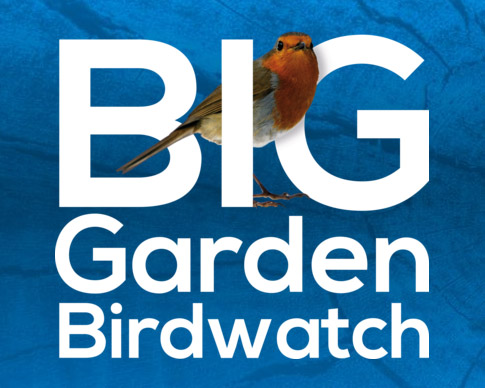January 2018
By Sandra Gibson
(Graphic from RSPB site)
Driving in Staffordshire this week I noticed more crows than usual; I’ve also noticed fewer starlings this winter. These are subjective impressions, of course, but more objective studies of Britain’s bird population have been undertaken. The RSPB survey is now in its 39th year and there’s going to be a Big Garden Birdwatch** on the last weekend of January (27th-29th). People are being invited to spend one hour counting birds and recording the results online. In last year’s Birdwatch, 497,961 people participated; if you would like to join in this year go to: www.rspb.org.uk/get-involved/activities/birdwatch/.
Why do this? On an individual level it is a pleasurable and interesting activity, which anyone can do. No expertise is required and no hardship is involved -you can sit in a chair looking out on your garden to do it. It’s a good way of helping to provide the RSPB with a great deal of information, which the organisation wouldn’t otherwise have the resources to amass. The collated observations give an overall picture of bird life in the British Isles, indicating declines and increases in bird populations and regional differences.
Bird numbers and types are influenced very much by the sort of habitat available. The garden census results are dependent on factors such as our hinterland: are there hills or mountains or woods or open land or water nearby, for example? Such things will determine whether or not birds move into gardens in the winter. Another influence is the number of urban gardens there are, and the proportion of gardens to built-up areas in urban centres. Also, the size of gardens has an effect: the bigger the garden, the more birds it can help sustain. In addition, local weather is a factor; so is climate change; so is pollution.
Recent trends*** in the North-west reveal low numbers of starlings – which corroborates my observations. They are only found in one third of Cheshire gardens, whilst greenfinches have declined 68% in ten years in Lancashire. On the other hand, goldfinches are on the increase in Greater Manchester and Merseyside, with more per garden than in many rural counties. House sparrows are mainly holding their own and are on the increase in Cumbria, where garden populations of blue tits, coal tits and jackdaws are found in higher percentages than anywhere else in England.
Declines in some regions are counterbalanced by success rates elsewhere. Starling populations are well up in County Armagh, Northern Ireland, and in Shetland. Robins struggle in Aberdeen but thrive in Argyll and Bute. Such variations are caused by the interaction of the factors – climate, hinterland, garden size, pollution – already mentioned.
These bird numbers are by no means fixed, though; a factor I haven’t mentioned is the human one. Individuals can intervene on behalf of dwindling populations and help maintain the numbers of more successful ones. We can make birds welcome by providing regular and regulated supplies of food. We can ensure that there is fresh water, give some consideration to safety, and choose plants that provide shelter and food for birds. Each bird will have its own food preference and its own preferred way of feeding. You can help starlings by not using pesticides, especially on grass, because they like to root about for grubs on lawns. You can get special starling nest boxes, just as you can for house sparrows. If you are feeding greenfinches from a hanging feeder, make sure you keep the feeder clean and move it from time to time. This keeps the ground underneath clean and also puts off predators from building up a killer routine. For the same reason, position food away from cat-concealing sheltered areas. Thrushes like to feed on the ground on fruits such as windfall apples so it’s a good idea to grow fruit-bearing plants for birds that like this in their diet. Blue tits and finches will devour your sunflower heads. If you find that food is decaying through being left, put less out. Make adjustments but don’t presume that because spring has arrived you can stop feeding. This is just the moment when there might be an energy gap when winter supplies such as berries are over, and the plenty of spring hasn’t yet started. Irrespective of food preferences, all birds need water, which will need thawing in cold weather.
We’ve all heard stories of predatory sandwich-stealing seagulls and witnessed the spikes placed on roofs and window-sills to deter pigeons; in Crewe ten years ago they felled a row of trees because the marauding starlings were roosting there and crapping on cars. But people mainly love birds and spend a lot of money on bird feed – one of the few items unaffected by the austerity years.
And I haven’t even started on the pleasure of bird song.
So – count a few birds?
* Also known as Rose Bay Willow Herb, the prolific wild flower called Fireweed, five feet tall with spikes of magenta flowers, cheers the hearts of those whose cityscape has become a bomb site or whose buildings have been cleared by machine. The dormant seeds spring to life after destructive events such as forest or man-made fires, hence the name, Fireweed. This occasional column will celebrate the persistence of wildlife in urban conditions.
** https://www.rspb.org.uk
*** Gardeners’ World Magazine, January 2018
